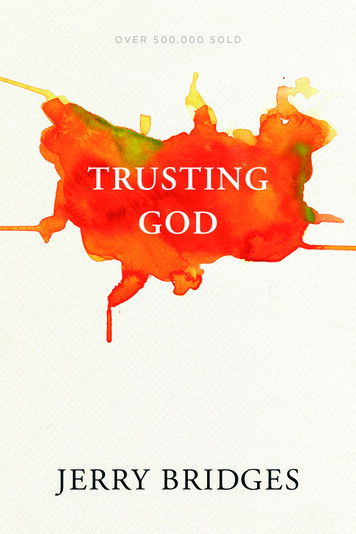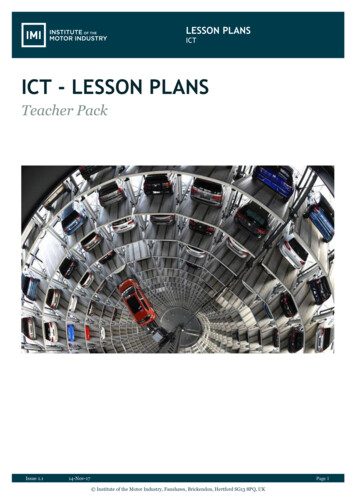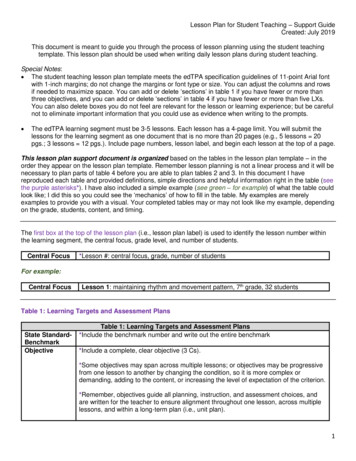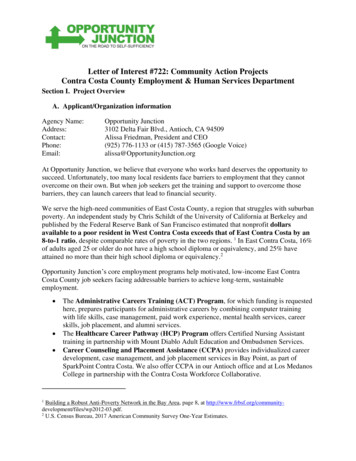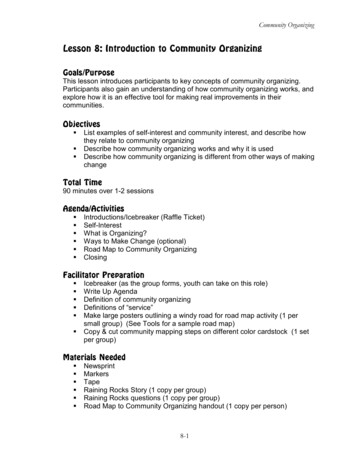
Transcription
Community OrganizingLesson 8: Introduction to Community OrganizingGoals/PurposeThis lesson introduces participants to key concepts of community organizing.Participants also gain an understanding of how community organizing works, andexplore how it is an effective tool for making real improvements in theircommunities.Objectives List examples of self-interest and community interest, and describe howthey relate to community organizingDescribe how community organizing works and why it is usedDescribe how community organizing is different from other ways of makingchangeTotal Time90 minutes over 1-2 sessionsAgenda/Activities Introductions/Icebreaker (Raffle Ticket)Self-InterestWhat is Organizing?Ways to Make Change (optional)Road Map to Community OrganizingClosingFacilitator Preparation Icebreaker (as the group forms, youth can take on this role)Write Up AgendaDefinition of community organizingDefinitions of “service”Make large posters outlining a windy road for road map activity (1 persmall group) (See Tools for a sample road map)Copy & cut community mapping steps on different color cardstock (1 setper group)Materials Needed NewsprintMarkersTapeRaining Rocks Story (1 copy per group)Raining Rocks questions (1 copy per group)Road Map to Community Organizing handout (1 copy per person)8-1
Community OrganizingTools Raining Rocks StoryRaining Rocks questionsRoad Map to Community Organizing8-2
Community OrganizingThe BasicsDirect action community organizing is one way to fix a problem. The thing thatmakes this method different from other ways of fixing problems is that it works tochallenge the power structure (pyramid of power) that allowed the problem tohappen in the first place.One well-known movement that successfully used direct action communityorganizing is the United Farm Workers, spearheaded by Cesar Chavez. Bybuilding coalitions with faith communities across the country and forging thesupport of unions, students, and consumers, Chavez built national support for along-standing boycott of grapes. Non-violent tactics like picketing and a 340-milemarch to Sacramento also focused attention on the struggles of farm workers.These combined actions resulted in the first successful U. S. farm workers unionand significant benefits for farm workers. Notably, the farm workers movementcrossed both racial and class lines, and involved women, such as DoloresHuerta, in strong leadership roles.Direct action community organizing is when people who are affected by aproblem decide on a solution, and with the strength of their numbers put pressureon politicians or whoever can make concrete improvements to the problem to doso. It’s about changing who has power; it’s about people coming together andbuilding power to get what they want.Two key concepts in community organizing are self-interest and communityinterest. Many people see self-interest as a bad thing but it’s not. Self-interestis your concern for your priorities, your health and safety, and those of peoplethat are connected to you (friends, family, neighbors). Community interest is acollective concern for priorities, health, and safety shared by a group of people.Self-interest and community interest motivate people to come together to getpower and make change.In this section youth are asked to think about their self-interest. They are alsoasked to consider different ways of making change, and the power that acommunity can have when its members decide to work together to solve aproblem.8-3
Community Organizing1.Self Interest10 minutesMaterials: noneAfter the raffle ticket icebreaker, have a short discussion about self-interest andcommunity interest, and how they are related to community organizing. Use thefollowing to guide your discussion: Ask youth to share their responses from the raffle ticket icebreaker “Why didyou come here today?” (eg., meet new people, fun, make my school orcommunity better). Explain that these are examples of self-interest.Read aloud the definition of self-interest: a concern for your own priorities,your health and safety, and those of people close to you.Ask participants: Do you think self-interest is good?Explain that self-interest can be good because it gets people involved inthings that are important to them.Next ask: What if your interest goes against what is good for mostothers? Is it still ok?Ask participants to complete the following sentence. If self-interest iswhat's good and important to one person then community interest iswhat 's important and good for . (Answer: a number ofpeople.)Explain that it is important to balance self-interest with community interest.Explain the connection to community organizing: People in power often use theirpower to satisfy their own self-interest. In community organizing, people cometogether to use their collective power to make sure that community interest ismet.8-4
Community OrganizingWhat is Organizing?12.30 minutesMaterials: Raining Rocks Story (1 copy per group), Raining Rocks questions (1copy per group)a. Explain that we are going to answer the question, “What is organizing?” Thedefinition we use is "the process of bringing people together to use theircollective power to win improvements in people's lives and challenge thepower structure."Let youth know that you are going to read a short story and then we’re going toanswer a few questions that will show what community organizing looks like.b. Read the Raining Rocks story out loud (see Tools at the end of this sectionfor handout).c. After the story has been read out loud, divide the group into three smallgroups corresponding to the three main groups in the story. Group (1) will be thevillagers who want to go up the mountain, Group (2) will be the villagers whowant to continue the rescue, and Group (3) will be Filthy Richbanks and hisfriends.Each group answers the questions for their group (see Tools for handout). Eachgroup should pick a recorder and someone to report back to the whole group.d. Facilitate report backs of each small group.e. Ask if anyone wants to comment on what they learned or observed.f. Then synthesize the activity: Point out that the exercise is about how to respond to a problem in thecommunity. Some people want to minimize the damage of the fall andothers want to stop the rocks from falling. 1As we can see from Harrison Hotel it is only through the second approachthat the boulders would actually stop. This is what organizing looks like -looking at the root of the problem and getting people together to fight to fixit.Adapted from Political Education Manual, SOUL: A School to Build a Movement.8-5
Community Organizingg. Ask, Does this mean that other ways to make change are not important?(Answer: No. There have to be many ways to fight the problems in ourcommunities and we need to respect all people who are trying to make changeand find solutions. However, we believe that organizing is the best way to makelasting change and address the root of the problem. Organizing can bring peopletogether so that they can create and support the solution to a communityproblem.)3.Ways to Make Change (optional)220 minutesMaterials: chalk and chalkboard or poster of ways to make changeDraw the diagram below on the board to use as a guide for discussing differentways to make change.Acceptspyramid of powerChallengespyramid of powerCommunityOrganizingAdvocacyEducationSelf HelpServicesa. Explain that there are different ways to make change and the major ones arelisted here on this graph. We’re going to go through an example to see differentways to fix a problem.The problem we’re going to look at is “there is nothing for young people to do.”Young people could go about getting things to do in many different ways.2Adapted from Organizing for Social Change, Midwest Academy.8-6
Community Organizingb. Go through each way to make change. Define each method for participants;write a one-to-two word explanation below each method as a guide forparticipants. Then ask the group to come up with an example of how to fixthe problem using that method. Add the example next to that method on thegraph. Repeat for each method of change.Providing Service: Supply basic services to people who need them, often tomeet basic needs such as food, health care, etc. What it looks like: An organization like the boys and girls club could providerecreational activities for teens and charge membership to cover the costs. Self Help: People affected by a problem do something to help each other.What it looks like: Teens plan and host weekly or monthly activities like dances,picnics, and sporting events.Education: Letting people know about issues so that people affected by theissue can understand the problem. What it looks like: A group of youth survey other teens about the lack of activitiesfor young people. They get an article published in the newspaper to let otherteens and parents know about the problem. They also include a list of resourcesabout the few teen activities going on in their community. Advocacy: A group or organization that cares about a problem pleads thecause on behalf of the group affected by the problem.What it looks like: The PTA or residents association could give testimony to themayor that the city should fund after-school activities for youth.(Direct Action) Community Organizing: Bringing people together to usetheir collective power to win improvements in people’s lives and challenge thepyramid of power. What it looks like: Teens organize. They come together and agree on a solutionthat meets their needs. With their strength -- and the support of parents andother teens -- they pressure the politicians and officials responsible to providemore teen activities.8-7
Community Organizingc. Discussion: Point out that each way of making change is connected differently to thepyramid of power challenging the pyramid of power. Services do notchallenge the pyramid of power, community organizing is based on Reinforce that community organizing is the approach we’re going to usebecause it (1) builds power within the community (2) lets you (the community)come up with the best solution for yourself and (3) seeks long-term solutionsto the problem.4. Road Map to Community Organizing30 minutesMaterials: blank road maps on newsprint (1 per group), a set of ‘pit stops’ (1 pergroup)a. Remind the group that when we talked about power we went over somevictories won through community organizing (eg, TIGHT, ECYC, and ETA). Now,we are going to get down to the specifics about how community organizing worksand the different steps to successful organizing.b. Explain that this activity is going to be like a road map. Each group is goingto get a road map and a set of pit stops. It is your job to decide together wherethe stops belong on the road map. Each map has ‘road signs’ on it – these areguides to help you figure out where the different pit stops belong.8-8
Community Organizingc. Use the following road map as a guide:8-9
Community Organizingd. Divide the large group into smaller groups of 3-5 people. Ask each group toidentify a reporter and a timekeeper for the group. Give the groups 10 minutes tocomplete their road map.e. Once completed, post the road maps where everyone can see them. Giveeach group 3 minutes to report back to the large group about their roadmap.Compare the different ways groups mapped their route. Groups might want tomake some changes after discussing together.Acknowledge that there is a general order to how community organizing worksbut that often making change takes a long time. So, sometimes changes happenwhile you are working to fix the problem and you might make changes along theway or repeat some steps.f. Emphasize that the action planning is critical to success! It might take sometime to research the issue and build relationships with the people on your side(allies), but it is worth it – because this will help you WIN.8-10
Tools – Lesson 8CommunityOrganizing
RAINING ROCKS STORY: A PARABLE3Once upon a time there was a little town in the mountains called Swisstown.One winter, a villager taking a walk in the hills finds a man lying in the snow – hehas been hit by a falling rock. The villager, being a very caring person, uses herjacket to bandage the injured man and carries him back down to the village.The next day two more people are hit by falling rocks, and they are rescued byother villagers. The next day, four people are hurt, then eight, then twenty. Lifebecomes dangerous for all villagers, because rocks keep falling down. A coupleof villagers sneak up the mountain and discover that the rocks are being thrownby a millionaire, Harrison Hotel, and his friends who hope to build a luxurioushotel and golf course in Swisstown. They are throwing the rocks hoping to get ridof the villagers so they can take over the land.The Disaster Relief Agency shows up in town. They set up a huge rescueoperation. They set up a clinic to heal the injured, send dogs to find injuredpeople who are lost outside, a shelter for those whose homes are destroyed, andsocial workers to help people deal with the traumatic effects of the falling rocks.Finally, The Disaster Relief Agency makes a giant net to place over Swisstown tostop the rocks from falling.One day, the net breaks and rocks fall on the village, injuring hundreds anddestroying homes, schools, and stores. The Disaster Relief Agency is workingfuriously to heal and provide shelter. From then on, rescue work becomes animportant part of the villagers’ lives. Everyone becomes involved in helpingthose hurt by the falling rocks.Three months later, at a town meeting, a group of villagers get together to makea proposal. They are sick and tired of the falling rocks, of their people being hurt,and they want to change the situation. They propose that the villagers unite andgo up the mountain to demand that Harrison Hotel stop dropping the rocks.Some disagree, saying that Swisstown’s rescue and relief efforts can’t afford it. Ifanyone leaves, there won’t be enough people power to rescue and tend to theinjured.The town is split in two groups – those who want to stay and keep up the rescueeffort going, and those who want to march up the mountain and confront HarrisonHotel.3Adapted from Political Education Manual, SOUL: A School to Build a Movement
RAINING ROCKS QUESTIONS4GROUP ONE: Villagers who want to go up the mountain Discuss the questions and pick one spokesperson who can explain youranswers to the larger group. In the story, what is your strategy in dealing with the falling rocks problem? Do you think your strategy is successful? Why or why not? How would the scenario end if your strategy is used?GROUP TWO: Villagers who want to keep up the rescue effort Discuss the questions and pick one spokesperson who can explain youranswers to the larger group. In the story, what is your strategy in dealing with the falling rocks problem? Do you think your strategy is successful? Why or why not? How would the scenario end if your strategy is used?GROUP THREE: The Millionaire and his friends Discuss the questions and pick one spokesperson who can explain youranswers to the larger group. Which of the two groups do you think you could work with more closely toachieve your goal? Which of the two groups is more threatening to you and your goal to builda golf course and luxurious hotel? What is your strategy in dealing with the two groups in order to achieveyour goal of building the golf course and luxurious hotel?4Adapted from Political Education Workshop Manual, SOUL: A School to Build A Movement
4. Road Map to Community OrganizingRoad Map to Community OrganizingRoad Map to Community Organizing 30 minutes Materials: blank road maps on newsprint (1 per group), a set of 'pit stops' (1 per group) a. Remind the group that when we talked about power we went over some victories won through community organizing (eg, TIGHT, ECYC, and ETA). Now,







